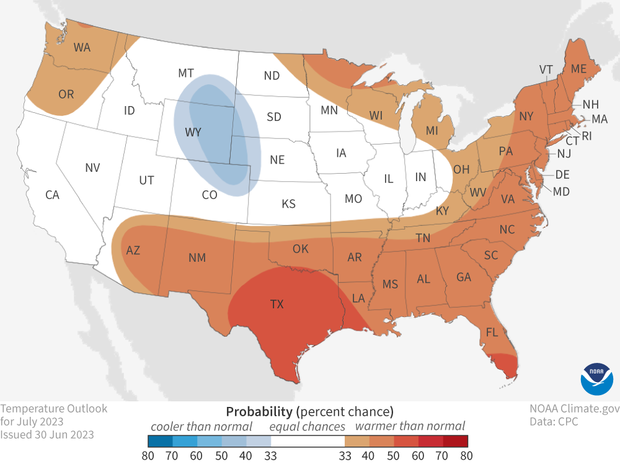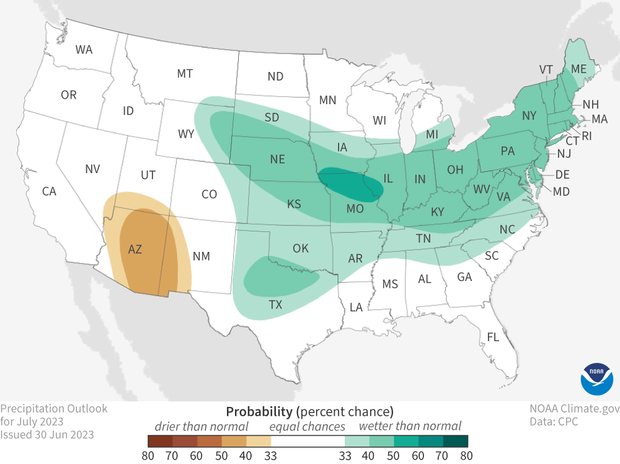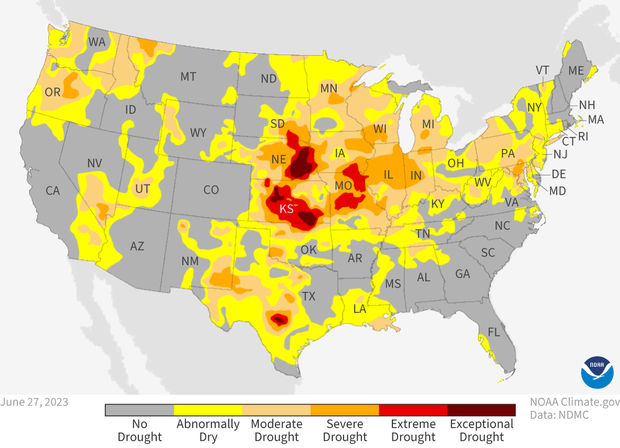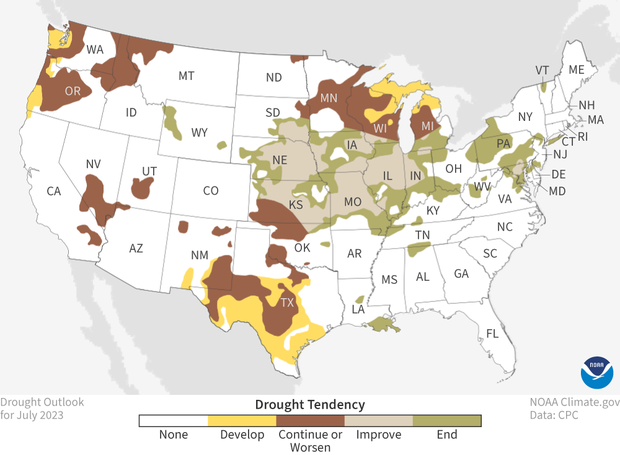U.S. climate outlook for July 2023
While below-average temperatures persisted during June in the eastern and southwestern parts of the nation, well above-average temperatures continued across the northern Plains. And a mid- to late month heat wave across Texas spread into the central Plains and Deep South as June came to an end. Is that a harbinger for July? Here’s what NOAA's Climate Prediction Center (CPC) expects.
The U.S. temperature outlook for July 2023 (view Alaska), showing places where a much warmer than average July is favored (orange to red) and where a much cooler than average July is favored (light to dark blues). White areas indicate that there are equal chances for a warm, cool, or near-average July. For more details on how to interpret these maps, read our explainer Understanding NOAA's monthly climate outlooks. Map by NOAA Climate.gov, based on data from the Climate Prediction Center.
On June 30, CPC released its updated monthly climate outlooks for temperature, precipitation, and drought across the United States for July 2023. In general, the outlooks favor well above normal temperatures across the southern and eastern parts of the country, with odds favoring well below-average temperatures in only a small region of the western Plains. The precipitation outlook favors well above average precipitation across much of the central and eastern portions of the country, with well below average precipitation favored only in parts of the Southwest.
The U.S. precipitation outlook for July 2023 (view Alaska), showing places where a much wetter than average July is favored (greens) and where a much drier than average July is favored (browns). White areas indicate that there are equal chances for a wet, dry, or near-average June. For more details on how to interpret these maps, read our explainer Understanding NOAA's monthly climate outlooks. Map by NOAA Climate.gov, based on data from the Climate Prediction Center.
Below, I’ll discuss the temperature and precipitation outlooks and the factors behind them, as well as the current state of drought and the monthly drought outlook for July. The usual reminder about the temperature and precipitation outlooks (more details): Maps show only the most likely outcome, but other outcomes are always possible, just less likely to occur. And areas in white have no tilt in the odds of above-, near-, or below-average conditions occurring (33.3% chance for each category).
These updated outlooks were produced considering the Week 1 forecast from the Weather Prediction Center (WPC), and CPC’s own Week 2 and Week 3-4 outlooks. Other tools that forecasters considered were various longer-range forecast models such as the Climate Forecast System (CFSv2). Forecasters did not weight current soil moisture conditions as heavily as they usually would in the summer because precipitation being forecasted for early in the month could drastically change the soil moisture patterns over the country.
Temperature Outlook
The June temperature outlook favors well above average temperatures across the southern tier of the country from the desert Southwest to the Southeast and along the entire East Coast. Highest probabilities (50-60%) favor a continuation of a hot summer over Texas, as above-average temperatures are favored in both the early- and latter-month outlooks. The weaker probabilities for above-normal temperatures (33-50%) across the remaining areas are the result of mixed signals for parts of these areas (particularly in the East) in the mid- versus the longer-term outlooks.
A very slight tilt toward above-average temperatures is also predicted for the Pacific Northwest, where above-average temperatures are strongly favored in the first half of the month. Below-average temperatures are only favored over Wyoming, southern Montana, northern Colorado, and western South Dakota and Nebraska, with cooler-than-average temperatures strongly forecasted early in the month. Potential episodes of smoke from the Canadian wildfires provides additional uncertainty to the July outlook across the central and eastern parts of the nation, as smoke tends to suppress daytime highs.
Precipitation Outlook
Above-average is the dominant category for the July precipitation outlook, favored across large parts of the central and eastern parts of the U.S. However, probabilities only exceed 50% in a small region mainly in northern Missouri, where above-average rainfall is favored during most of the month. Rainfall is also favored to be above-average in a region extending from the central and southern Plains eastward across the Ohio and Tennessee Valleys and the across the mid-Atlantic into the Northeast. Above-average precipitation is favored in all outlooks, but with only very modest probabilities. This is often the nature of summertime rainfall, with much of it falling in scattered hit and miss showers and thunderstorms that often don’t influence overall monthly precipitation anomalies (departures from average) over large areas.
Odds for drier-than-average conditions are only favored in the Southwest during July. While this outlook does appear in the Week 2 and Week 3-4 outlooks from numerical weather models, the driving factor behind this prediction is the developing El Niño. During many previous El Niño episodes, the onset of the Southwest’s normal summer monsoon precipitation has been delayed. Probabilities of dryness are quite modest though, as it is also possible that Hurricane Beatriz in the eastern Pacific could trigger a monsoon moisture surge during the first half of the month.
Drought Monitor
Drought conditions across the contiguous United States as of June 27, 2023. Extreme (red) and exceptional (dark red) drought was confined to the heart of the Great Plains. NOAA Climate.gov map, based on data from the U.S. Drought Monitor Project. For more details on drought, visit Drought.gov.
The amount of drought increased across the United States during June, with the percent of the contiguous U.S. in drought increasing from about 19% at the end of May to 27% by the end of June. However, much of this drought currently qualifies as only moderate drought (D1), and the percent of the country in the two most intense categories (D3-D4, representing extreme and exceptional drought) actually decreased slightly during June to under 3%.
In the last four weeks, drought improved significantly in Florida (up to a 3-class improvement, resulting in drought removal) and also in much of the southern and western Great Plains. The improvement in the panhandles of Texas and Oklahoma was such that severe and extreme drought (D2 and D3) were eliminated, a remarkable occurrence for a 4-week period. On the flip side, drought developed or worsened from the Midwest into the Northeast, with degradation of up to 3 classes observed across the Corn Belt and around the Great Lakes. Extreme and exceptional (D3 and D4) drought largely persisted in the Central Plains.
Drought Outlook
The July 2023 drought outlook for the contiguous United States (view Alaska, Hawaii, and Puertp Rico). Yellow areas are likely to see drought develop. Brown areas are likely to see drought persist. Tan means drought is likely to improve at least 1 category, and green means drought is likely to end. NOAA Climate.gov map, based on data from NOAA Climate Prediction Center.
For June, drought is expected to improve from the Central Plains eastward into the mid-Atlantic in those regions likely to experience above-average rainfall during the month. The areas currently experiencing moderate drought should see drought removal, with areas in more significant and entrenched drought likely seeing improvement, but with drought remaining.
Regions in the central part of the nation currently in drought to the north and south should expect drought to persist. Across the Great Lakes, dryness early in July may also promote drought expansion, while persistent, excessive heat and drier conditions favor more widespread drought expansion for Texas. With early monsoon activity favored to be weak, some drought expansion is likely in parts of southern New Mexico. Finally, some drought expansion is possible west of the Cascades, with the tilt toward above-average temperatures, as we head into the driest month of the year in the Pacific Northwest.
To read the entire discussion of the monthly climate outlooks from the Climate Prediction Center, check out their website.



